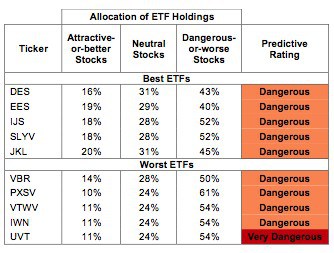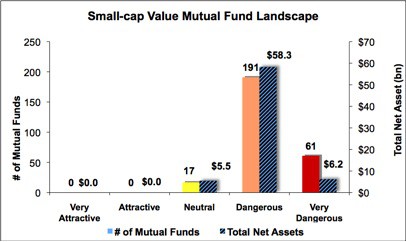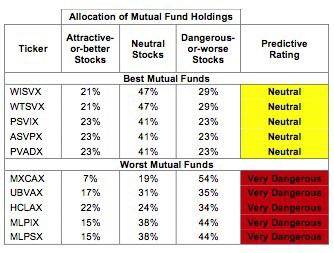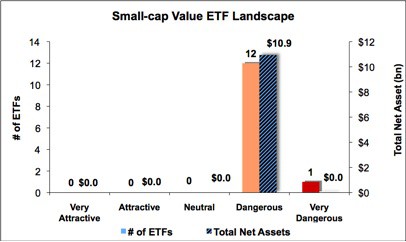The small-cap value style ranks last out of the twelve fund styles as detailed in my Style Rankings for ETFs and Mutual Funds report. It gets my Dangerous rating, which is based on aggregation of ratings of 13 ETFs and 269 mutual funds in the small-cap value style as of February 13th, 2013. Prior reports on the best & worst ETFs and mutual funds in every sector and style are here.
Figures 1 and 2 show the five best and worst-rated ETFs and mutual funds in the style. Not all small-cap value style ETFs and mutual funds are created the same. The number of holdings varies widely (from 20 to 1667), which creates drastically different investment implications and ratings. The best ETFs and mutual funds allocate more value to Attractive-or-better-rated stocks than the worst, which allocate too much value to Neutral-or-worse-rated stocks.
To identify the best and avoid the worst ETFs and mutual funds within the small-cap value style, investors need a predictive rating based on (1) stocks ratings of the holdings and (2) the all-in expenses of each ETF and mutual fund. Investors need not rely on backward-looking ratings. My fund rating methodology is detailed here.
Investors should not buy any small-cap value ETFs or mutual funds because none get an Attractive-or-better rating. If you must have exposure to this style, you should buy a basket of Attractive-or-better rated stocks and avoid paying undeserved fund fees. Active management has a long history of not paying off.
Get my ratings on all ETFs and mutual funds in this style on my free mutual fund and ETF screener.
Figure 1: ETFs with the Best & Worst Ratings – Top 5
 * Best ETFs exclude ETFs with TNAs less than $100 million for inadequate liquidity.
* Best ETFs exclude ETFs with TNAs less than $100 million for inadequate liquidity.
Sources: New Constructs, LLC and company filings
First Trust Small Cap Value AlphaDEX Fund (FYT) and Vanguard S&P Small-Cap 600 Value ETF (VIOV) are excluded from Figure 1 because their total net assets (TNA) are below $100 million and do not meet our liquidity standards.
Figure 2: Mutual Funds with the Best & Worst Ratings – Top 5
Sources: New Constructs, LLC and company filings
Fenimore Asset Management Trust: FAM Small Cap Fund (FAMFX) and Baird Funds, Inc: Baird SmallCap Value Fund (BSVIX) are excluded from Figure 2 because their total net assets (TNA) are below $100 million and do not meet our liquidity standards.
WisdomTree SmallCap Dividend Fund (DES) is my top-rated small-cap value ETF and earns my Dangerous rating. Westcore Trust: Westcore Small-Cap Value Fund (WISVX) is my top-rated small-cap value mutual fund and earns my Neutral rating.
ProShares Ultra Russell2000 Value (UVT) is my worst-rated small-cap value ETF and ProFunds: Mid-Cap Value ProFund (MLPSX) is my worst-rated small-cap value mutual fund. Both earn my Very Dangerous rating.
Figure 3 shows that 351 out of the 2159 stocks (over 20% of the market value) in small-cap value ETFs and mutual funds get an Attractive-or-better rating. However, none out of the 13 small-cap value ETFs and none of the 269 small-cap value mutual funds get an Attractive-or-better rating.
The takeaways are: mutual fund managers allocate too much capital to low-quality stocks and small-cap value ETFs hold poor quality stocks.
Figure 3: Small-cap Value Style Landscape For ETFs, Mutual Funds & Stocks
 Sources: New Constructs, LLC and company filings
Sources: New Constructs, LLC and company filings
As detailed in “Cheap Funds Dupe Investors”, the fund industry offers many cheap funds but very few funds with high-quality stocks, or with what I call good portfolio management.
Investors need to tread carefully when considering small-cap value ETFs and mutual funds, as 100% of ETFs and 94% of mutual funds in the small-cap value style earn a Dangerous-or-worse rating. No ETFs or mutual funds in the small-cap value style allocate enough value to Attractive-or-better-rated stocks to earn an Attractive rating. Focus on individual stocks instead.
Lexmark International, Inc. (LXK) is one of my favorite stocks held by small-cap value ETFs and mutual funds and earns my Very Attractive rating. LXK is a solid, if unspectacular, performer. It has grown after tax profit (NOPAT) by 4% compounded annually for the past 13 years. A current free cash flow yield of 11% bodes well. Rigorous back testing has shown that companies with a free cash flow yield of >10% consistently outperform the S&P 500 by a wide margin. The most attractive aspect of LXK, however, is its extremely low valuation. At its current share price of ~$23.30, LXK has a price to economic book value ratio of 0.3. This ratio means the market is expecting LXK to experience a permanent decline of 70% inNOPAT. Such low market expectations combined with strong historical performance means good risk/reward for investors.
Sovran Self Storage, Inc (SSS) is one of my least favorite stocks held by small-cap value ETFs and mutual funds and earns my Very Dangerous rating. SSS has experienced a decline in NOPAT for two out of the past three years. It has not earned positive economic profits in any year going back to 1998 when our model begins. Despite these poor results, SSS is valued at ~$67/share. This valuation implies 19% growth in NOPAT compounded annually over the next 15 years. Such high expectations seem overly optimistic for a company with no recent track record of economic profitability. SSS offers investors too much risk for too little potential reward.
Figures 4 and 5 show the rating landscape of all small-cap value ETFs and mutual funds.
My Style Rankings for ETFs and Mutual Funds report ranks all styles and highlights those that offer the best investments.
Sources: New Constructs, LLC and company filings
Figure 5: Separating the Best Mutual Funds From the Worst Funds
 Sources: New Constructs, LLC and company filings
Sources: New Constructs, LLC and company filings
Review my full list of ratings and rankings along with reports on all 13 ETFs and 269 mutual funds in the small-cap value style.
Sam McBride contributed to this report.
Disclosure: David Trainer and Sam McBride receive no compensation to write about any specific stock, sector or theme.


